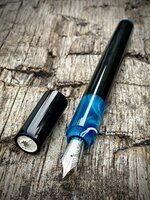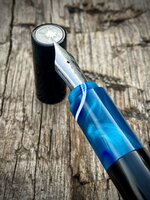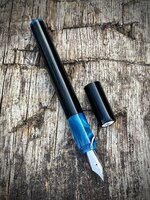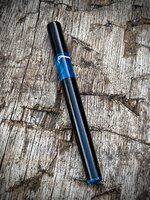I find this style of pen, where the cap threads onto the end of the section, is useful when working with thin raw materials. A lot of the vintage cellulose materials come in 13mm diameter or less (and is often pre-drilled). Making a more traditional pen, where the cap fully envelopes the section and screws onto the barrel, would result in quite a slim pen (or very thin cap walls). So I opt for this instead. This style is by no means unique to me but it is my preferred option in these cases.
In this example the material is vintage black cellulose acetate which starts out looking like a battered old bicycle inner tube but polishes up beautifully. The blue section is made using original Aqua so Bologna acrylic from the now defunct Omas factory. I also use this on the end of the barrel to seal the pen. My sterling silver finial coin performs the same function at the end of the cap.
I use both M10 and m11 threads on the section and the pen is around 13mm in diameter with just a hint of a waist to the section. It has a Bock no6 nib.
Cheers
Ash





In this example the material is vintage black cellulose acetate which starts out looking like a battered old bicycle inner tube but polishes up beautifully. The blue section is made using original Aqua so Bologna acrylic from the now defunct Omas factory. I also use this on the end of the barrel to seal the pen. My sterling silver finial coin performs the same function at the end of the cap.
I use both M10 and m11 threads on the section and the pen is around 13mm in diameter with just a hint of a waist to the section. It has a Bock no6 nib.
Cheers
Ash





